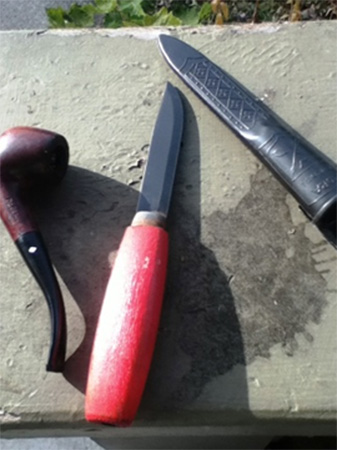
*Adding a Patina to a Carbon Steel Knife Blade*
This very short article came about upon request of a Rubie who wished to see a post on the Rubicon made more permanent.
I am very partial to Mora knives. They are inexpensive, unassuming and quite sturdy. They don't look "tacticool." They don't have a meaningless acronym attached to them. They have no "special features." They are just knives, but they are good ones. Others may need more "knife", or a more specialized one, but between a Mora and a multitool I have all the "knife" I've ever needed.
Most Moras are made from carbon steel, which is easier than stainless to sharpen to a razor's edge. Carbon steel, alas, rusts. I've owned several Moras and, with enough use, they develop discolorations even if perfectly cared for. Not being stainless steel, they "stain."
We can avoid this staining and even rusting in general by putting a "patina" on the blade. I'm no metallurgist. I don't understand the process well enough to explain. I gather the very outermost molecules of metal are changed "rusted" in a certain harmless manner, so to say in such a way that the more damaging kind of rust cannot take place. It does not eliminate the need to oil the knife, but it does put a more robust finish on the blade.
Last year I attempted to put a patina on one of my Moras by smearing mustard all over it, then wrapping it in plastic and leaving it for a while. I'd read a recommendation of the method and, knowing no better, decided to try it myself. The result was unsatisfactory. The surface of the knife was mottled; the coverage was incomplete, and more than just a bit unattractive.
A few days ago, while looking for something else entirely, I found a blog whose author put a patina on his Mora using vinegar as the reacting agent, achieving a much more uniform result. It was very inexpensive and the result looked much more like what I'd wanted to do in the first place. The blog essay is here: http://www.mungosaysbah.com/2009/12/blueing-my-mora-knife-applying-rust.html The author calls the process "bluing." I asked about it on the Rubicon. Members who know what they're talking about call the finish a "patina" and the process "rust bluing."
This weekend I did just this to two of my Moras. Here is a photo of the smaller one:

My pipe has no real reason for being in the photo it just happened to be on the porch at the same time my daughter snapped the picture
Here's exactly what I did it's ridiculously simple:
What started out as a bright shiny Mora two days ago came out the same color and luster as pencil graphite. I rubbed some vegetable oil on the blade and it looks darn near parkerized, boasting a handsome sheen.
Feeling ambitious, I tried the same process on the Mora I'd given the mustard treatment. Setting it in the solution like the other knife, it got a black surface like the first. Upon wiping down, it came away mottled, though much less so than previously. I cleaned the knife, then rubbed it with 0000 steel wool. This made the finish even more uniform, though not nearly so dark as the first knife. After several iterations of dunking, cleaning and polishing, however, the finish is much nicer and darker. This added business of polishing and re-applying is based on a website yet another expert Rubie suggested: http://hickmanrifles.com/content/rust-bluing This website makes the claim that items treated by this process "tend to be more rust resistant than any other method."
This second knife, slightly larger than the first, is my preferred Mora anyway, so I'm glad I have an opportunity to undo something I can only charitably call a learning experience.
I must add one last note. There is a band of metal around the handle of Mora knives with wood handles, right where the handle meets the blade. You can see it on the knife in the photo. This metal, when immersed in the vinegar solution, does not get dark like the blade it simply rusts. It must be buffed with steel wool and oiled.
It's nice to know I can now give my favorite knives a true rust-preventive treatment which is not only easy but very inexpensive a gallon of vinegar is less than $3.00.
gvi
www.alpharubicon.com
All materials at this site not otherwise credited are Copyright © 1996 - 2013 Trip Williams. All rights reserved. May be reproduced for personal use only. Use of any material contained herein is subject to stated terms or written permission.